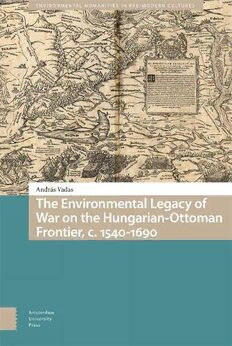
The Environmental Legacy of War on the Hungarian-Ottoman Frontier, c. 1540-1690 PDF
Preview The Environmental Legacy of War on the Hungarian-Ottoman Frontier, c. 1540-1690
The Environmental Legacy of War on the Hungarian-Ottoman Frontier, c. 1540–1690 Environmental Humanities in Pre-modern Cultures This series in environmental humanities offers approaches to medieval, early modern, and global pre-industrial cultures from interdisciplinary environmental perspectives. We invite submissions (both monographs and edited collections) in the fields of ecocriticism, specifically ecofeminism and new ecocritical analyses of under-represented literatures; queer ecologies; posthumanism; waste studies; environmental history; environmental archaeology; animal studies and zooarchaeology; landscape studies; ‘blue humanities’, and studies of environmental/natural disasters and change and their effects on pre-modern cultures. Series Editor Heide Estes, University of Cambridge and Monmouth University Editorial Board Steven Mentz, St. John’s University Gillian Overing, Wake Forest University Philip Slavin, University of Kent The Environmental Legacy of War on the Hungarian-Ottoman Frontier, c. 1540–1690 András Vadas Amsterdam University Press Cover illustration: Hadtörténeti Intézet és Múzeum [Military History Institute and Museum] (Budapest, Hungary) H III a 24 [Karte des ungarischen Kriegsschauplatzes vom Jahre 1556.] Cover design: Coördesign, Leiden Lay-out: Crius Group, Hulshout isbn 978 94 6372 793 8 e-isbn 978 90 4855 201 6 doi 10.5117/9789463727938 nur 685 © A. Vadas / Amsterdam University Press B.V., Amsterdam 2023 All rights reserved. Without limiting the rights under copyright reserved above, no part of this book may be reproduced, stored in or introduced into a retrieval system, or transmitted, in any form or by any means (electronic, mechanical, photocopying, recording or otherwise) without the written permission of both the copyright owner and the author of the book. Every effort has been made to obtain permission to use all copyrighted illustrations reproduced in this book. Nonetheless, whosoever believes to have rights to this material is advised to contact the publisher. In memory of Papa Table of Contents List of Figures 9 Note on Names 11 Acknowledgments 13 1 Introduction 15 1.1 Frontier, Border – Do They Mean Anything? 23 1.2 The Development of the Ottoman-Hungarian Frontier – The Scene 26 1.3 Transdanubia and the Great Hungarian Plain – The Setting of the War 34 1.4 The Book’s Concept 40 2 From the Center to the Frontier 47 The Environment of Central Transdanubia in the Early Modern Period 2.1 Why Hydrography Matters: Military Defense and Waterscape in the Kingdom of Hungary 50 2.2 Summary 77 3 A Century of Water? 79 The Rába Valley in the Seventeenth Century 3.1 Primary Sources from a Town by the River 82 3.2 The Rába at Körmend 89 3.3 Floods – The Unintended Consequences of Dams and Mills? 103 3.4 Low Water – An Even Less Fortunate Event? 125 3.5 Was Körmend an Exception? Some Conclusions 129 4 From Endless Forests to Meadows and Wastelands? 137 What Happened to the Forests Along the Border? 4.1 Forest Resources in the Carpathian Basin in Pre-Modern Times – Endless or Scarce? 138 4.2 Reconstructing Forest Cover in the Early Modern Period – Perspectives and Limitations 146 4.3 Forms of Wood Consumption in Early Modern Hungary – Paved Road to Deforestation? 151 4.4 The Biggest “New” Consumer? The Wood Consumption of the Military Defense in the Sixteenth and Seventeenth Centuries 170 4.5 Forests in the Hinterlands – What Were They Used For? – A Brief Outlook 185 4.6 Conclusions 193 5 Conclusions 197 5.1 Epilogue – What Came After? 201 Appendices 207 Bibliography 239 Index of Geographic Names 285 Index of Personal Names 289 List of Figures 1.1 Major geographical units of the Carpathian Basin 35 1.2 The Ottoman Empire and the Kingdom of Hungary in the second half of the sixteenth century 37 2.1 The map of Woldemár Lászlóffy, “Water-Covered Areas and Wetlands in the Carpathian Basin Before the Beginning of Flood Protection and Drainage Works.” 49 2.2 The Rábaköz on the detail of a manuscript map from 1673 66 2.3a-b The settlements, dams, fords, and buildings referred to in the 1543–1544 survey of the Rába River 76 3.1 The estate complex of the Batthyány family in the middle of the seventeenth century 83 3.2 Geographical coverage of the private letters studied 86 3.3 Annual distribution of letters studied from Körmend and Csákány (1600–1659) 87 3.4 Körmend in the 1570s 90 3.5 The beginning and length of the reconstruction of the Traun bridge at Wels in the light of the bridge masters’ accounts (1521–1574) 97 3.6 The dates of building work on the mill dam and Körmend’s fortifications by calendar years 109 3.7 The seasonal distribution of letters sent from Körmend (1600–1659) 113 3.8 The number and seasonality of floods on the Rába River (1543–1658) 113 3.9 Classification of the intensity of historical floods in Western and Central Europe 115 3.10 The magnitude of the floods on the Rába between [1543] 1600 and 1659 116 4.1 Forest cover in the Carpathian Basin in the Late Middle Ages and the frontier zone in the early modern period 147 4.2 The population fluctuation of the counties of Transdanubia from the late medieval period to the late eighteenth century 157 4.3 The main types of earth and wood fortifications used in the Carpathian Basin 173 5.1 Malomsok and the branches of the Rába on the First Military Survey 204
